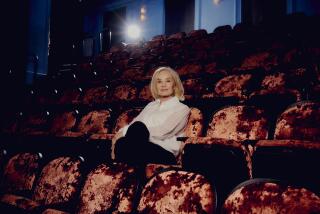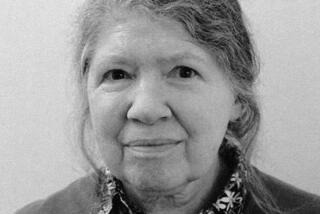Madeleine L’Engle, 88; author of ‘A Wrinkle in Time,’ which won a Newbery Award in ’63
- Share via
Madeleine L’Engle, whose enduring children’s classic “A Wrinkle in Time” enchanted and provoked generations of readers with its often lyrical melding of science fiction, fantasy and morality, has died. She was 88.
The author died of natural causes Thursday at a nursing home in Litchfield, Conn., said Jennifer Doerr, a publicity manager at Farrar, Straus and Giroux, her longtime publisher.
L’Engle, who had homes in New York City and Goshen, Conn., wrote more than 60 books, including memoirs, spiritual meditations and adult fiction.
A complicated woman who once described herself as “lightly Episcopalian,” she often disdained the fact that she was known best as a children’s author, even though her writing for young readers brought her a 1963 Newbery Award, the field’s highest honor, for “A Wrinkle in Time” (1962). It was the first installment in a trilogy that includes “A Wind in the Door” (1973) and “A Swiftly Tilting Planet” (1978).
“Wrinkle” tells the story of Meg Murry, a girl who travels through space and time to rescue her father, a brilliant scientist imprisoned on a distant planet. A tale of good vs. evil that is laden with mysticism and ambiguous notions of deity, it has ranked as one of the bestselling children’s books in history with more than 8 million copies sold, but it also has been one of the most banned.
The story opens on the proverbial dark and stormy night with a visit to the Murry household by a strange woman named Mrs. Whatsit. When she leaves, she tells the Murrys in an offhand manner that “there is such a thing as a tesseract,” a comment that makes Meg’s mother turn white.
The tesseract, as later explained, is the cosmic corridor -- the “wrinkle” in unseen dimensions -- that Meg and her precocious brother will be transported through to find their missing father. In the process, they encounter a “Dark Thing” that is enveloping the universe, including Camazotz, the planet where their father is being held.
Published the same year as the Cuban missile crisis and in the midst of the race to the moon, the book intrigued some readers and disturbed others with its allegorical nature. What, for instance, was the “Dark Thing”? Was it communism, or an invasion by angry green men from another world? Were Mrs. Whatsit and her sisters, Mrs. Which and Mrs. Who, witches?
L’Engle offered several interpretations over the years. In her Newbery acceptance speech in 1963, she said, “There are forces working in the world as never before in the history of mankind for standardization, for the regimentation of us all, or what I like to call making muffins of us, muffins all like every other muffin in the muffin tin.”
By the 1990s, “Wrinkle” was the 23rd most banned book, according to the American Library Assn., largely due to critics who found anti-Christian themes in its pages. The attacks distressed L’Engle at first, but in later years her attitude was “Ah, the hell with it,” she told the New York Times a few years ago. “It’s great publicity, really.”
She did not deny that “Wrinkle,” like much of her fiction, was heavily autobiographical. Like her protagonist, Meg, she grew up feeling like an oddball. She was the only child of Charles Wadsworth, a foreign correspondent and author, and Madeleine Camp, a pianist, who were middle-aged when she was born. Placed in a succession of boarding schools in the U.S. and abroad, she sought solace in books and wrote her first story when she was 5. Although shy and introspective, she was not a “muffin” but an iconoclast who once argued with a teacher that three times zero could not be zero.
At Smith College in the late 1930s, she knew she was going to be a writer. After graduating in 1941, she moved to New York City and in 1945 she published her first novel, “The Small Rain,” which revolved around a lonely boarding-school student sustained by her dedication to music.
L’Engle was also interested in acting and joined the Civic Repertory Theatre founded by Eva le Gallienne. She made her debut in a production of “The Cherry Orchard” in 1943 and in 1946 married a fellow actor, Hugh Franklin, who later gained fame as Dr. Charles Tyler in the long-running soap opera “All My Children.”
Next spring Farrar, Straus and Giroux will publish an autobiographical novel that L’Engle wrote in the 1940s called “The Joys of Love,” about a young woman who pursues a career and finds love in the theater.
Franklin died in 1986 and their son Bion in 1999. L’Engle is survived by two daughters, Josephine F. Jones and Maria Rooney; five grandchildren; and five great-grandchildren.
After marrying, she and Franklin moved to Goshen, where they bought an old farmhouse. It became the setting for “A Wrinkle in Time” and several books about a family called the Austins, including “Meet the Austins” (1960).
In a series of unrelated tragedies, L’Engle lost several close friends in the span of a few years, which led her to grapple with deep philosophical questions.
Her quest for answers led her to quantum physics and eventually to her most famous novel.
“I had to have something that made sense, and I wasn’t finding anything that made sense in the logical places,” she told National Public Radio in 1998. “And then I just came across a phrase of Einstein’s, which completely excited me. He said, ‘Anyone who is not lost in rapturous awe at the power and glory of the mind behind the universe is as good as a burned-out candle.’ And I thought, ‘Oh! There’s my theologian.’ ”
She conceived “Wrinkle” as a story about the universe and wrote it with an adult audience in mind. The completed manuscript was rejected by more than two dozen publishers, who found it fit no clear-cut category. It was finally read by John Farrar of Farrar, Straus and Giroux, who attended the same church as L’Engle’s mother. Although his company had rejected the book earlier, Farrar liked it and agreed to publish it as a children’s book.
Among the laudatory reviews it received was one in the Saturday Review, which said “Wrinkle” had “mystery, mysticism, a feeling of indefinable brooding horror” and was “original, different, exciting.”
L’Engle, who for many years was the librarian and writer-in-residence at the Cathedral Church of St. John the Divine in New York, explored religious themes in many of her books, including “A Ring of Endless Light,” which examined death.
She also wrote several memoirs, including “A Circle of Quiet” and “Two-Part Invention: The Story of a Marriage,” which her family dismissed as fiction in a controversial 2004 New Yorker profile of the author. They said her novels offered truer glimpses into her life
“Writing is like a fairy tale,” L’Engle told the magazine. “It happens elsewhere.”
--
More to Read
Sign up for our Book Club newsletter
Get the latest news, events and more from the Los Angeles Times Book Club, and help us get L.A. reading and talking.
You may occasionally receive promotional content from the Los Angeles Times.











